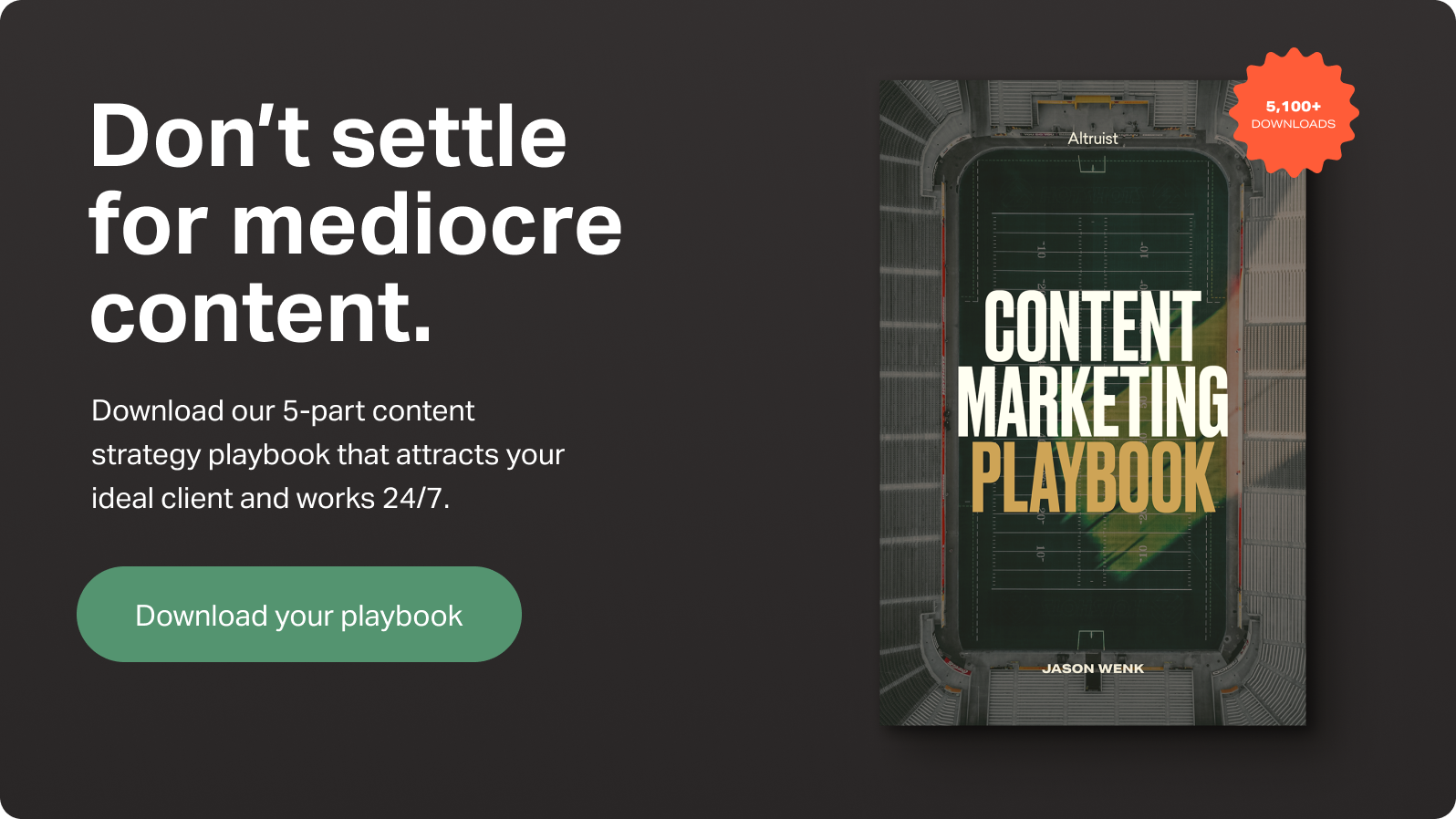Great financial advisor content offers prospects valuable insight while establishing you as a credible source. It builds trust, enhances brand awareness, and can generate leads for your firm.
This brief article covers the types of content you should consider and how to start creating content.
Types of content to get started
While each content medium will have different requirements for creation and optimization, they all serve a similar purpose: providing value to prospective clients. Choosing a medium you enjoy is important because it will help you stay consistent with your output. And consistently producing new content keeps you top of mind, which helps to develop a connection with your audience.
Financial advisor blogs
Blogs help drive traffic to your website. A well-crafted article enables you to rank on search engines. Where you rank depends on how well your article is optimized for SEO and how accurately it matches the searcher’s intent. Once on your site, the content must be high-quality, offering insightful and valuable information to the reader. Doing so will encourage readers to explore your site and inspire them to take action, such as subscribing to the blog (or booking a call with you).
Podcasts
Advisors use podcasts to establish themselves as industry experts through thought-provoking discussions, timely advice, and much more. It’s low-pressure for your audience because they can tune in while multitasking or on the go. Consistent podcast episodes keep you engaged with your audience, encouraging listeners to subscribe for notifications whenever an episode drops.
Webinars
Webinars help advisors connect with their audience in real-time–regardless of location. Advisors can showcase their services and expertise, and the audience can ask questions.
Pre-recorded video content
With media giants like YouTube and now TikTok, videos can result in high engagement rates if done right. Video content is also easy to share on various platforms as this medium continues to grow in popularity.
Social media posts
Daily social media posts engage prospects, helping them become familiar with you and your brand. Most platforms favor reels and high-quality images–making it easier to repurpose content across platforms. Social media platforms, such as Linkedin, favor long-form content to keep users on the platform longer–so you can repurpose content from your blog.
Here’s where to start creating content as a financial advisor
Set aside time for content creation
Creating high-quality content takes time, so you must set aside a portion of your schedule for brainstorming, drafting, editing, and distribution preparation.
Brainstorm ideas
Stellar content starts with an idea, and the best place to receive ideas is from your clients (prospects will likely have the same concerns/interests as your clients). Get a pen and paper and start answering the following questions:
- What are my clients consistently worried about?
- What relevant concerns has my firm solved?
- What questions am I repeatedly answering among my clients/prospects?
- What upcoming trends or predicaments do investors need to know about?
Will my audience find this information valuable?
Look at your answers, and see if any themes are present. Amongst those themes, can you create a valuable asset that will resonate with your audience? A valuable asset solves a question or provides an alternative perspective prospects haven’t considered yet. It should be easy to digest and may offer best practices, educational information, or actionable takeaways.
If the topic checks all the boxes, this is the idea(s) to move forward with.
Assemble your piece (outline)
An outline will organize your argument/points into a proper structure, helping you draft content that’s well thought out and easy to digest for your audience.
Three primary components for an effective outline:
- Identify the problem (explain what it is)
Identifying the problem is the foundation for your content. It lets the audience know what they will learn from this piece. Start macro and explain why this is an important topic to pay attention to. - Agitate the problem (how it impacts your audience)
People pay attention when it affects them. Help your audience visualize how this explicitly impacts them and what will happen if they don’t take action. - Present a solution (action steps they can take right now)
Guide your audience to take action. Showcase your expertise and genuine concern to help them improve through your financial advice. Doing so will help you build a connection of trust and establish your credibility.
Draft your content
Drafting content will vary by medium type, but how you present the story is similar. Whether it’s a blog or a script for a video/podcast, every content medium must ask a question that needs an answer.
Using your outline, you can pinpoint the questions to highlight and how to answer them best for the audience. To further clarify, the questions you highlight identify the problem, and the answers explain how it relates to the audience and how to solve the problem.
- Incorporate examples and anecdotes
Personalize the audience experience by including relevant examples/anecdotes. Doing so will make the piece stand out and show your genuine interest in creating a piece for their immediate use.
- Call to action
Every piece of content should have a call to action. It doesn’t have to be a hard sell every time, but it should align with your goal for the piece. Depending on the asset, maybe there's a natural progression to check out a similar article. Or, if it’s a bit of a harder-sell piece, the call to action would be to schedule a consultation with you.
Edit your content
Editing requires you to be objective–seeing the work through your audience’s eyes. Read/watch/listen a few times, then let it simmer for 24 hours. After that, review it with fresh eyes as you may catch something you initially missed.
We touched on “value” a moment ago, and it’s essential to ask yourself again: Will my audience find this valuable? Is it concise and easy to comprehend? Are there relevant examples to support key points? Does anything need to be added or, more importantly, removed (aka ditching the clutter)? Clutter is an unnecessary distraction and can devalue your content. The quicker you can present an idea and solution, the quicker your audience will establish your credibility.
Proofread your content
Specifically for written content, aim to keep it in an active voice, straightforward language, short sentences, and plenty of white space to make it skimmable. Consider having a colleague proofread it, or invest in a service like Grammarly to help ensure it’s polished and free of grammatical errors. Also, try reading it out loud a few times. Doing so helps catch any awkward phrases, typos, or errors.
Prepare for distribution
Depending on your content type, guidelines per platform may vary. For example, if it’s a blog post or a Youtube video, it must be SEO optimized. If you’re producing social media content, it must follow specific dimension requirements, including captivating captions. It’s necessary to familiarize yourself with each platform’s guidelines to give your content the best chance of success.
SEO
Search engine optimization is critical for discoverability. Targeting and incorporating the right keywords in your content will help you rank higher in results–increasing your chances of being seen by your audience. This guide will walk you through an effective SEO strategy to improve your chances of landing on page 1 (no one visits the 2nd page).
Email marketing
Email is a valuable tool for distributing content and staying in touch with prospects. Deliver high-quality content straight to their inbox when they need it the most. This guide lists the various types of email marketing you can incorporate into your strategy and best practices.
Facebook Ads
Ensure your target audience sees your content. Facebook Ads enable financial advisors to reach prospects with tailored content to inspire them to act. Learn more about the Facebook Ads strategy and why it works for content.
Conclusion
Think of content creation as a way to connect with your audience meaningfully. You’re there to help make their lives easier, and with content, you can do this before they ever speak directly to you. Start with what you know best and build your content marketing from there. Remember, in content marketing, your authentic voice is key.
Explore this guide to learn more about digital content marketing for financial advisors.














